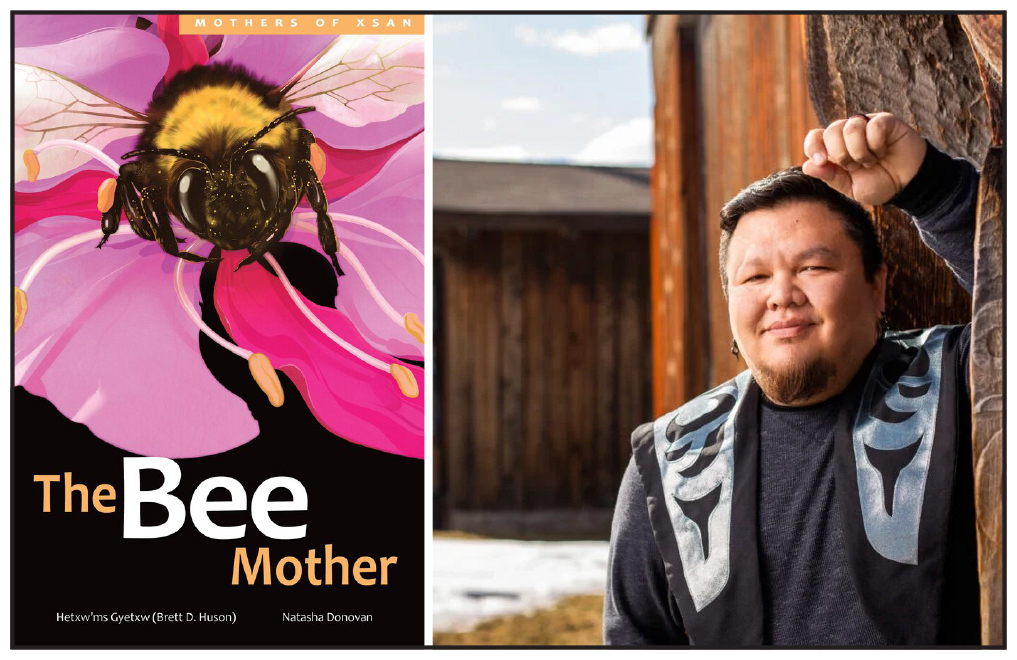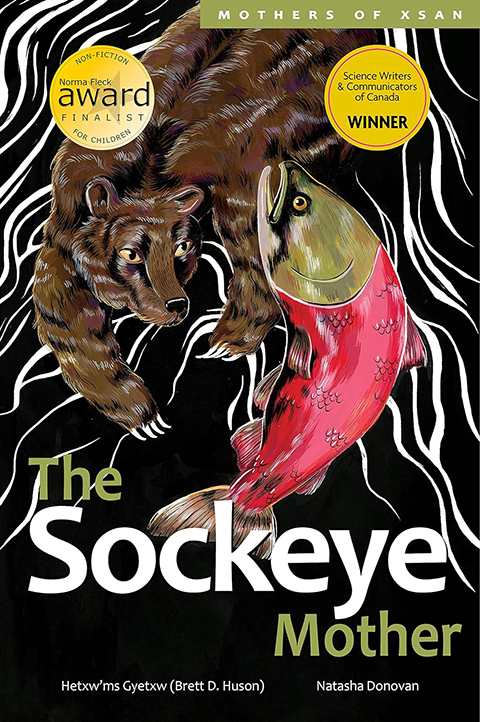
By Odette Auger, Windspeaker Buffalo Spirit Reporter
“The Bee Mother” is the seventh in a series of 10 children’s picture books in The Mothers of Xsan series by Hetxw’ms Gyetxw Brett D. Huson (Gitxsan) and illustrator Natasha Donovan (Métis/settler).
The Mothers series explores environmental and ecological themes through Gitxsan worldviews, teachings, and protocols.
“I spent a lot of time with Elders, knowledge carriers and educated members of our nation,” Huson said, those “educated through our systems, as well as the Western education system.
“The Mothers of Xsan series was a natural progression for me to share my stories,” he says, “a small window into the life cycles that are a part of the natural biodiversity of Gitxsan lands.”
“The Bee Mother” book, available for pre-order now for a May release, explores types of bees. Bee Mother Nox Ap is nature’s gardener, essential as a pollinator. Readers will learn the important role of the bumblebee, honeybee and yellow jacket wasp in the Xsan ecosystem.
As a knowledge carrier himself, Huson’s website explains that his work is centered on challenging stereotypes and tokenization of Indigenous knowledge systems. He is a member of the Science Committee for Adaptation Futures 2023 (adaptationfutures.com)
He is also a research associate at the Prairie Climate Centre at the University of Winnipeg, developing the Indigenous Knowledges section of the Climate Atlas (climateatlas.ca). Huson has also contributed to adapting the "two-eyed seeing" methodology, which aims to unite Indigenous and Western scientific approaches in a respectful and meaningful way.
“Two-eyed seeing” is a way of seeing research through the concepts of Western methodologies while using Indigenous perspectives to help guide what types of information we are looking for and how we interpret that information from the research, Huson explained. It’s using different perspectives to seek out greater understanding.
“Gitxsan people already have their own forms of observation and understanding. We have our research.”
“Culture is what shapes each nation's perspectives. The understanding that there is a pluriverse of perspectives about the world isn’t new, but it is within the realm of industrialized Western education systems,” Huson explained.
“Culture is the cornerstone to bringing everyone new life and creative energy. It is with culture that Indigenous peoples from what is now called the Americas creatively used new methods of agriculture to create foods like corn, squash, potatoes, tomatoes, different types of peppers and other fruits,” said Huson.
“These cultural ways of seeing the world guided the people's storytelling and artistic practices and shaped the whole world as we know it.”
The Mothers of Xsan series sets out to show that “the Gitxsan nation's understanding of the life cycles of flora and fauna parallels Western scientific understandings and sometimes will broaden the perspectives of readers of all ages,” said Huson.

Natasha Donovan, whose mother is Métis from the Meadow Lake, Sask. area, credits her career in illustration to Huson, who found her ink drawings of salmon online. He shared her artwork with Portage and Main Press, and Donovan was hired to illustrate Huson’s first Mothers of Xsan book, “The Sockeye Mother”, in 2016. The salmon drawings were inked with a brush and coloured in Photoshop.
Donovan emphasizes the importance of centering the perspective of the author in communicating his words through visual art. For “The Bee Mother”, she drew the drafts in pencil, later inking/colouring them digitally in the Procreate program.
“I don't know if every illustrator thinks this way,” says Donovan, “but I personally like to see my job as sort of a translator. I'm receiving the text and it's going through me and becoming something else.”
“But I really think it's very important to center the perspective of the author,” says Donovan.
The amount of to and fro between herself and the author varies widely from project to project, and working with Huson for seven years has created a strong understanding.
“A lot of projects that I received, the authors have not met before. I often don't even speak to them because everything gets mediated through the publisher,” Donovan said. “So that feels like the most substantial difference between any other project and working on the Mothers of Xsan series, just that we have this implicit understanding of what we are creating together.”
The work begins with a manuscript from Huson, usually sectioned into pages, and Donovan creates a draft of drawings. The author will add some drawings, “every thread has some art done by Brett,” she explained.
The illustrator will suggest where the formline drawings could go, the style of art characteristic of Northwest Coast Indigenous design, and then illustrator and author collaborate.
“I’ll make suggestions in the rough draft, and it goes back to him and editors, and I move on to the final lines and colour.”
It’s important to Donovan that Huson is the one to draw the formline parts of the illustrations, as Gitxsan design elements are his visual language.
“Formline is so incredibly important to the nations of the Pacific Northwest. Not only is formline an abstract art style, but the art form is also an expression of our understanding of the world, Huson said.
“We believe there are building blocks to life and that our existence’s energy or ‘spiritual’ side controls a physical side. This physical side is expressed by the specific shapes of formline art. We used the colour black in our paintings because we believed that the charred remains left after anything is burned make up all of the physical elements in the world,” Huson says.
“So when we express through the art, we are also teaching,” he said.
For Donovan, her heritage’s role in her creativity comes from an intuitive, instinctive place, she said.
“Creativity– any other part of my being–emerges from the particular combination of the family and the environment that made me.”
Donovan hopes her illustrations in The Mothers of Xsan series bring optimism and joy to young readers.
Huson’s hope for the series is that it leaves young readers “more interested in learning about all the things that make our world work. The audience will have many more questions and begin to learn about the land they call home to better understand how it works and sustains their lives.”
“Being more aware of the land helps us look toward the future,” says Huson.
The Mothers of Xsan series also includes “The Grizzly Mother”, “The Frog Mother”, “The Raven Mother”, “The Wolf Mother”, and “The Eagle Mother”. All are available on Amazon or where you buy your books.
